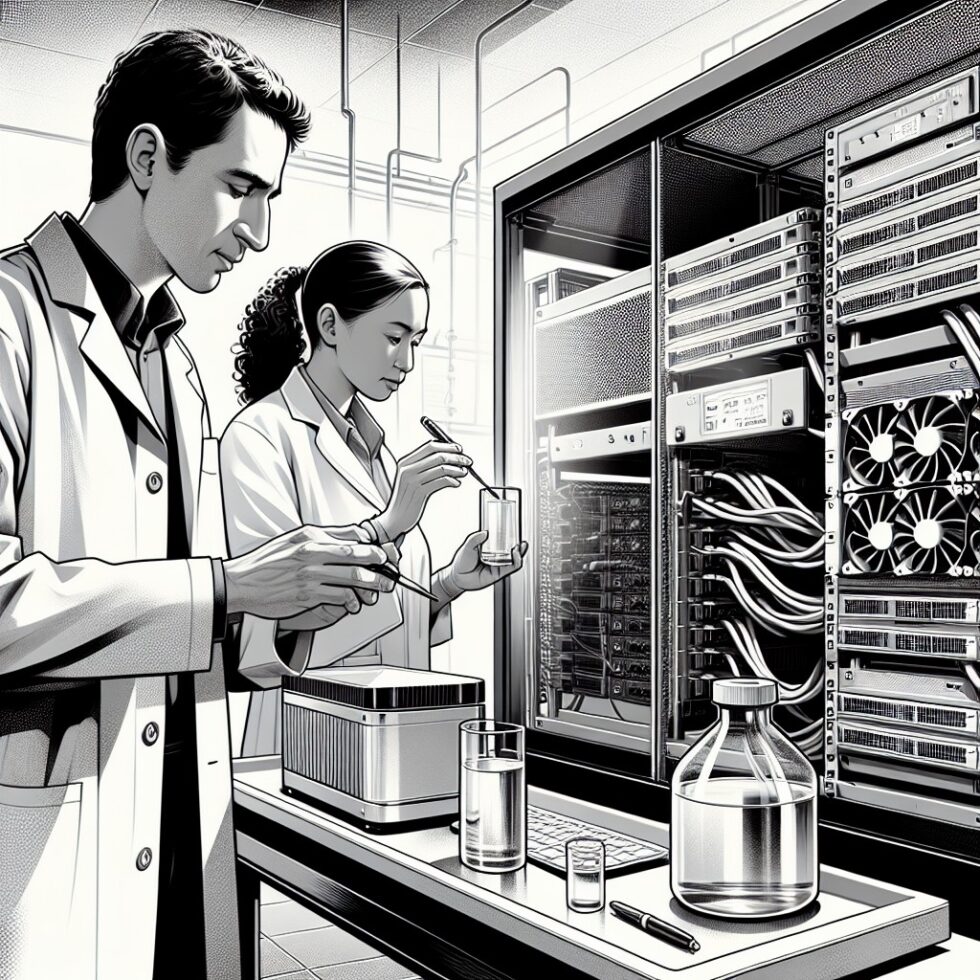
Compute is getting hotter. A single accelerator can dissipate more heat than an entire rack did a decade ago. Fans are louder. Aisles are warmer. And even well‑managed hot/cold aisle containment starts to feel like a hair dryer. It’s not hype—air cooling alone is running out of room in many environments. Liquid cooling is no longer exotic; it’s a practical set of options you can choose, install, and maintain without turning your building into a science project.
This article explains the three liquid cooling families you are likely to encounter, how to plan the plumbing and controls, what efficiency and cost look like in real life, and how small teams can start safely. It’s vendor‑neutral, focused on clear decisions and straightforward trade‑offs. If you can run a rack and keep a maintenance log, you can run liquid cooling.
Why Air Cooling Is Hitting Limits
Air is a convenient coolant. It’s everywhere, non‑toxic, and easy to move. But air’s heat capacity is low. Pushing more heat means pushing more air, which means bigger fans, higher noise, and greater power consumption. At the rack level, even a well‑sealed cold aisle struggles when a single rack wants 30–80 kW of heat removal, and some AI or HPC racks push beyond that. You can still use air for the rest of the system—drives, DIMMs, VRMs—but the hottest components need a better path to carry heat away.
Liquid solves this by moving heat with far less volume and pressure. The fluid picks up heat at the source and transports it to a heat exchanger or cooling plant. The result is lower fan speeds, tighter temperature control, and a path to scale density without a noisy wind tunnel.
The Liquid Cooling Families You’ll Actually Use
Not all liquid cooling is the same. You can choose from three families that map neatly to different needs and constraints. Knowing their strengths will save you money—and headaches.
Rear‑Door Heat Exchangers (RDHx)
An RDHx looks like a thick rack door. Air from the servers passes through a liquid‑cooled coil mounted on the back, which pulls heat out of the exhaust air and returns cooler air to the room. The servers remain air‑cooled internally; you’re simply moving the heat transfer out of the room and into a fluid loop.
- Best for: Densities in the ~20–50 kW/rack range, fast retrofits where you cannot change servers.
- Pros: Low intrusion; works with existing servers; preserves standard maintenance routines; easy to scale per rack.
- Cons: Still relies on chassis fans; you need sturdy floors and careful hose management; coil performance depends on water temps and flow.
- Watch for: Door swing clearance, service corridors, quick‑disconnect quality, condensate risk if supply water is too cold in humid rooms.
Direct‑to‑Chip (D2C) Cold Plates
In D2C, a liquid cold plate sits directly on the hottest components (CPUs, GPUs), pulling heat into a closed loop that returns to a coolant distribution unit (CDU) or facility water loop. Air still cools the rest of the board, but fan speeds drop because the big heaters are handled by liquid.
- Best for: High‑density compute nodes and accelerators with known thermal envelopes; clusters where you control the server SKUs.
- Pros: Excellent thermal performance; lower acoustic noise; lower fan power; often plug‑and‑play with certified server SKUs.
- Cons: Requires server models designed for cold plates; hoses and manifolds inside racks need thoughtful installation; leaks are rare but must be planned for.
- Watch for: Compatible quick disconnects (dripless, pressure rated), materials compatibility (aluminum vs. copper), coolant chemistry, and CDU capacity and redundancy.
Immersion Cooling (Single‑Phase and Two‑Phase)
With immersion, entire server boards (typically stripped of moving fans) are placed in a bath of dielectric fluid. Heat transfers directly into the fluid and then to a heat exchanger. Two sub‑types exist:
- Single‑phase immersion: The fluid stays liquid; pumps circulate it through a heat exchanger.
- Two‑phase immersion: The fluid boils at low temperature on hot surfaces, then condenses on a coil; heat removal can be extremely efficient.
- Best for: Very high densities, consistent workloads, or sites prioritizing acoustic comfort and high efficiency.
- Pros: Outstanding heat transfer; simplified server airflow; very low fan power; quiet operation; potential to run on warmer water.
- Cons: Requires immersion‑ready hardware and handling procedures; fluid cost; tank footprint; service workflows differ from traditional racks.
- Watch for: Fluid selection and supply chain, seals and gaskets compatibility, lift‑assist tools for heavy cassettes, and staff training for wet handling.
Plumbing and Plant: The Loops That Matter
Liquid systems are really just loops. Get the loops right, and the rest follows. You will often see a facility water loop (FWS) tied to a chiller or dry cooler, and an IT loop connected to servers or doors. They meet at a heat exchanger or CDU. That separation keeps IT fluid clean and protects the facility from contamination.
Coolant Distribution Units (CDUs)
A CDU is a compact box with a pump, heat exchanger, controls, and filters. It sits near a row or in a mechanical room, connecting the IT loop to the facility loop.
- Why you need it: Pressure control, isolation between fluids, filtration, and local redundancy (N+1 pumps, dual power supplies).
- How to size: Add up the heat load of attached racks, then size for growth and redundancy. Look at flow rate (L/min or GPM), temperature rise, and allowable pressure drop through cold plates or doors.
Fluid Choices and Chemistry
For D2C and RDHx, the coolant is usually water or water‑glycol in the IT loop. Water is a great heat carrier but can freeze or corrode if mismanaged. A small glycol percentage prevents freezing and helps biocontrol in certain climates; however, glycol raises viscosity and slightly reduces heat capacity. Never mix chemistries randomly. Follow your vendor’s guidelines, use deionized or properly conditioned water, and keep detailed records of additives.
For immersion, you’ll choose a dielectric fluid. Options include single‑phase hydrocarbon blends and engineered fluorinated fluids for two‑phase. Check for material compatibility (elastomers, plastics, solder mask), vapor pressure, and supplier stability. Create a fluid management plan: storage, testing, top‑ups, and end‑of‑life recycling.
Pipes, Hoses, and Quick Disconnects
Pipes carry the facility loop; flexible hoses and manifolds serve racks. Use dripless quick disconnects rated for your pressure, temperature, and fluid. Color‑code supply and return. Label everything. Build in service loops so you can pull servers without stressing hoses. If you’ve ever done airline or hydraulic work, the same discipline applies here—and pays off.
Leak Detection and Prevention
Modern fittings drastically reduce leak risk, but plan assuming a leak could happen. Place drip trays and moisture sensors under manifolds. Use sloped floors or channels to direct spills away from power. Train staff on rapid shutoff. And treat connector hygiene like sterile field protocol: clean caps, lint‑free wipes, and no open ports near dust.
Control, Monitoring, and Alarms
Liquid adds new signals to your monitoring. That’s a good thing—you get rich telemetry. Your DCIM or observability stack should track:
- Supply and return temperatures for each loop
- Flow rates and pump speeds
- Differential pressure across plates/doors and across filters
- Coolant quality metrics (conductivity for water, particulate counts, inhibitor concentration)
- Leak sensors and sump levels
Set meaningful thresholds. For example, a sudden drop in differential pressure can indicate a bypass or leak; a rise can mean a blocked filter. Tie alarms to clear runbooks so on‑call staff know exactly what to check and in what order.
Retrofit vs. Greenfield: Choose Your Path
New builds get to pick the “clean sheet” approach: slab floors, ceiling busways, large CDUs, and dedicated mechanical rooms. If you’re retrofitting, the decision tends to flow from what you can change.
If you are retrofitting:
- Start with RDHx if your servers are not D2C‑ready. You can lift rack density without swapping hardware.
- Use modular CDUs that can live near your hot rows when mechanical room space is scarce.
- Consult a structural engineer for tank loads if you consider immersion; fluids are heavy, and you need safe access for handling cassettes.
- Plan hose routing and drip trays to coexist with existing cable raceways and PDUs.
If you are greenfield:
- Design for higher supply water temps when possible; warmer water unlocks free cooling and improves efficiency.
- Reserve space for growth in CDUs, manifolds, and utility corridors. Today’s 40 kW rack may be 80 kW tomorrow.
- Pick a standard early (manifold interfaces, quick connects, fluid spec) to simplify future procurement and spares.
Efficiency and Cost: What Changes and What Doesn’t
Efficiency metrics help you decide if the project pencils out.
- PUE (Power Usage Effectiveness): Liquid cooling often reduces fan power and mechanical chiller use, lowering PUE. But beware of oversimplification; PUE is site‑specific.
- WUE (Water Usage Effectiveness): Some liquid systems use less water than traditional chilled‑water plants because they can run at higher water temps and leverage dry coolers. Others may use more if tied to evaporative systems. Measure, don’t guess.
- Energy Reuse: If you capture waste heat for a building or district heating loop, you can reduce your effective energy footprint. This matters to communities and regulators.
On costs, break it into CapEx and OpEx:
- CapEx: RDHx is generally the least intrusive; D2C requires compatible servers; immersion needs tanks and different service tooling. Add CDUs, piping, and installation labor.
- OpEx: You’ll likely save on fan power and potentially on chillers if you can use warmer water. You’ll add periodic filter and fluid maintenance. For immersion, budget for fluid testing and top‑ups.
Run a simple total cost of ownership model. Include energy price assumptions, projected rack densities, maintenance intervals, and the value of freeing floor space. If you can fit more compute per square meter, the argument often tilts in favor of liquid even before energy savings.
Heat Reuse: Turning Waste into a Resource
Liquid cooling makes heat reuse easier because the heat is already concentrated in a fluid loop, often at temperatures suitable for secondary uses. Consider:
- Building heat: Offices, labs, or pools near your facility can use 30–50°C water for preheating.
- District networks: Some cities operate low‑temperature heat grids; your facility can feed them with a plate heat exchanger and metered control.
- Process use: Greenhouses, drying, or industrial preheating may be practical if located nearby.
This is more than a sustainability story; it’s a revenue or cost‑offset opportunity. If you’re negotiating a lease or planning community benefits, a heat reuse plan can make your project more welcome—and more profitable.
Operations: Keep It Simple and Documented
Liquid cooling demands discipline, not heroics. Small habits prevent big problems.
Routine Tasks
- Daily/weekly: Check flow and temperature deltas, the CDU dashboard, and leak panels. Walk the floor and listen—quiet fans make other noises easier to catch.
- Monthly: Inspect quick connects for wear; verify sensor calibrations; test a subset of leak alarms and shutoff valves.
- Quarterly: Replace filters per pressure drop, not just calendar; sample fluid for particulate and chemistry; review trends for early drift.
Spare Parts and Tools
- Quick disconnects and o‑rings matched to your exact spec
- Filters for the CDU and manifolds
- Coolant and additives in sealed containers
- Absorbent pads, spill kits, lint‑free wipes, and caps
- Torque wrenches, fluid‑safe gloves, and eye protection
- Lift assists for immersion cassettes if applicable
Label and log everything. When hose A goes to manifold B port 3, write it down and print it. Record every filter change, every fitting swap, and every top‑up. Your future self will thank you.
Security and Safety: Not Just for Networks
Water doesn’t respect badge boundaries, and fluids belong under the same rigor as power and network. Lock CDU cabinets. Badge‑restrict manifolds. Maintain MSDS sheets for all fluids onsite and train staff on handling. If your site uses glycol or engineered fluids, store them in approved cabinets and track inventory. Simple measures keep auditors and insurers calm—and your team safe.
Small Labs and “Starter” Deployments
Not every site needs a megawatt plant. If you run a small AI or HPC lab, or you’re a maker space or university team, you can still use liquid safely:
- Start with a single RDHx rack tied to a compact wall‑mount CDU and a dry cooler outside. This is often enough to double or triple rack density.
- For D2C, choose certified nodes from your server vendor to avoid DIY plate retrofits. Use vendor‑approved quick connects and follow their torque specs and runbooks.
- If you try immersion, go single‑phase first. It’s more forgiving. Train on handling boards, ensure adequate fire separation, and plan for heavy lifts.
- Mind the floor. A single tank filled with fluid and hardware is heavy. Get a structural opinion for your exact slab or raised floor.
Keep the first build simple. Once you and your facilities partner have a clean, documented install, scaling to the next rack or tank is straightforward.
Vendor Conversations: Questions That Get Real Answers
- Performance: What supply and return temperatures are assumed? What flow rates per cold plate or door?
- Compatibility: Which server SKUs are certified? What are the materials in the wetted path?
- Reliability: What’s the MTBF for quick disconnects? How are leaks detected and isolated?
- Maintenance: Filter part numbers, change intervals, and fluid testing kits. Who provides training and documentation?
- Controls: SNMP, Modbus, or REST APIs for telemetry. How do alarms integrate with your DCIM?
- Support: Spare lead times, regional service coverage, and warranty terms that reflect real usage.
Design Patterns That Work
Warm‑Water Cooling
Run the facility loop as warm as your IT side allows. Warmer water increases free‑cooling hours and makes heat reuse more practical. Coordinate with server vendors to set inlet temp limits that balance component reliability and efficiency.
N+1 Where It Counts
Pumps fail. Filters clog. Build N+1 at the pump level inside CDUs and for the CDUs serving a high‑value row. Isolation valves on every branch let you service parts of the system without downtime.
Short Loops, Clean Loops
Keep the IT loop short to reduce volume and risk. The facility loop can be longer and more complex. Use a plate heat exchanger to decouple them, and protect the IT loop with higher filtration standards.
Environmental Notes: Doing More with Less
Liquid cooling is sometimes framed as “using more water,” but context matters. If your design eliminates evaporative cooling or reduces chiller hours, your net water usage can go down. And if you enable heat reuse, your overall energy picture improves. The right approach is to model your site with real climate data and load profiles. Then track PUE, WUE, and heat reuse metrics continuously. That’s how you avoid greenwashing and deliver credible results.
What the Next Two Upgrade Cycles Will Demand
Processor roadmaps point to higher TDPs and more accelerators per node. Even if you can squeeze one more refresh out of air with aggressive containment, plan now for hybrid air/liquid or full liquid. The benefit isn’t only density—it’s predictability. With liquid, you control temperatures tightly, making performance more consistent and component life more stable. That simplifies capacity planning and reduces noisy “hot day” surprises.
Summary:
- Air alone struggles at modern rack densities; liquid carries more heat with less energy and noise.
- Choose among RDHx, direct‑to‑chip, or immersion based on density, hardware control, and service workflow.
- Design clean loops with CDUs to decouple IT and facility water; size for flow, delta‑T, and redundancy.
- Get fluid chemistry right, standardize quick disconnects, and monitor temps, flows, pressures, and leaks.
- Retrofits favor RDHx or certified D2C nodes; greenfields can target warm‑water operation and heat reuse.
- Model PUE, WUE, and total cost. Liquid often wins on energy, density, and floor space over time.
- Runbooks, spares, and labeling keep operations calm. Train staff and log every change.
- Start small if needed; a single rack with a compact CDU can unlock significant density safely.
External References:
- ASHRAE Thermal Guidelines for Data Processing Environments
- Open Compute Project: Advanced Cooling Solutions
- The Green Grid: PUE, A Comprehensive Examination
- Google: Data Center Efficiency and Cooling
- NVIDIA H100 Datasheet (Thermal Characteristics)
- Intel: Thermal Mechanical Design Resources
- Dell Technologies: Direct Liquid Cooling for High‑Density Data Centers
- GRC: What Is Immersion Cooling?





